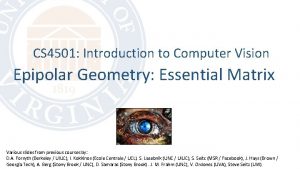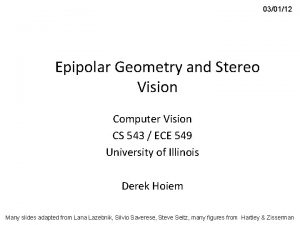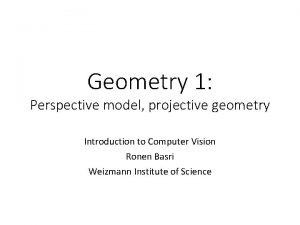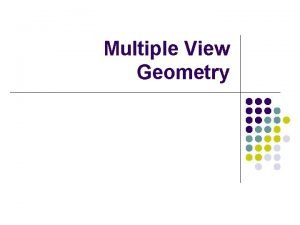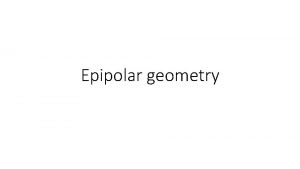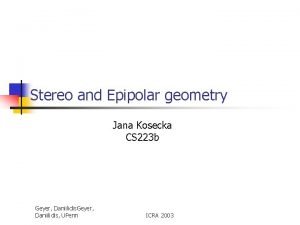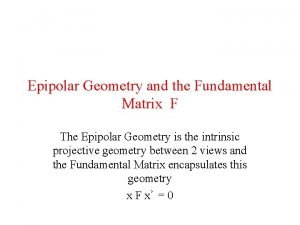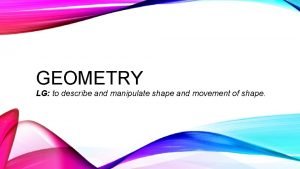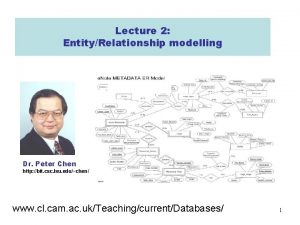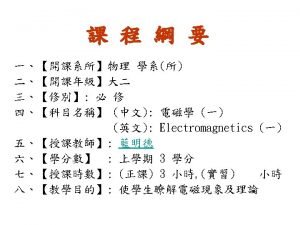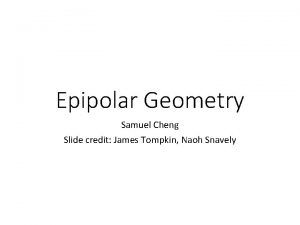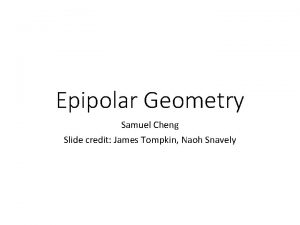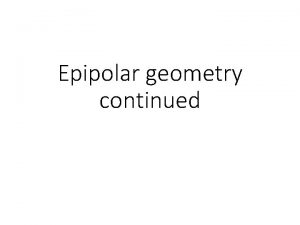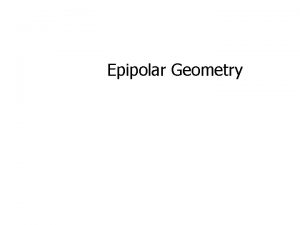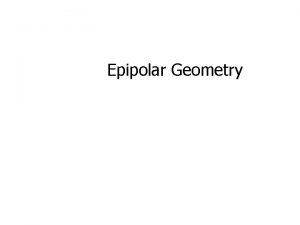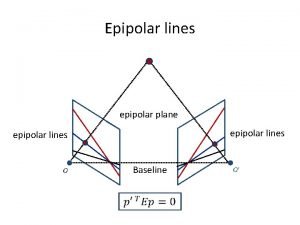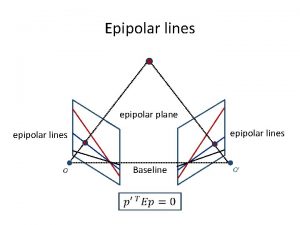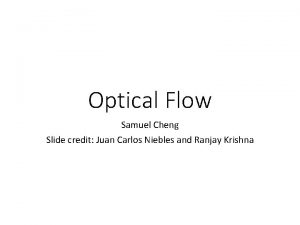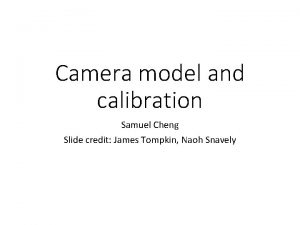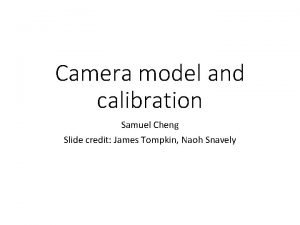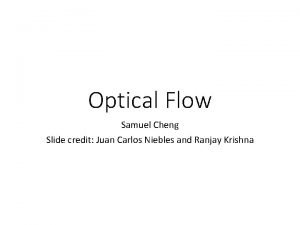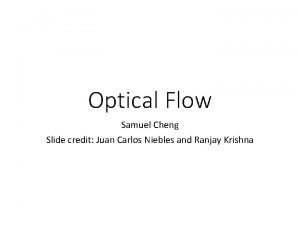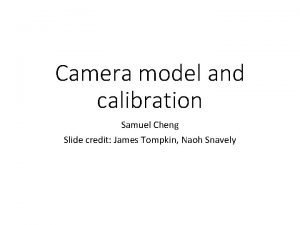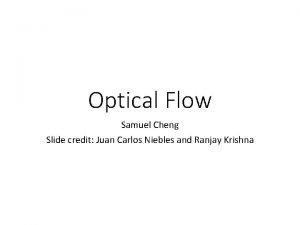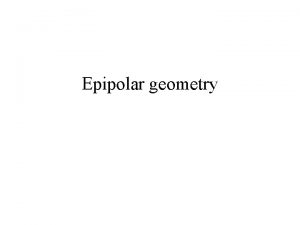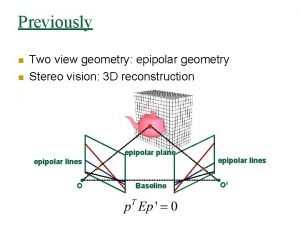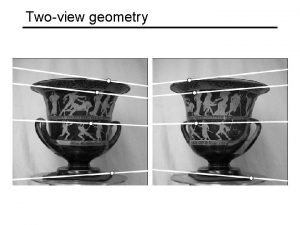Epipolar Geometry Samuel Cheng Slide credit James Tompkin


















































- Slides: 50

Epipolar Geometry Samuel Cheng Slide credit: James Tompkin, Naoh Snavely

Frederick Kingdom

Structure from motion

Structure from motion • Given many images, how can we a) figure out where they were all taken from? b) build a 3 D model of the scene? This is (roughly) the structure from motion problem

Structure from motion Reconstruction (side) (top) • Input: images with points in correspondence pi, j = (ui, j, vi, j) • Output • structure: 3 D location xi for each point pi • motion: camera parameters Rj , tj possibly Kj • Objective function: minimize reprojection error

What we’ve seen so far… • 2 D transformations between images • Translations, affine transformations, homographies… • 3 D coordinates to 2 D coordinates • Camera matrix • Today: epipolar geometry and fundamental matrices

Depth from disparity • Goal: recover depth by finding image coordinate x’ that corresponds to x X X z x x x' x’ f O f Baseline T O’

Geometry for a simple stereo system • Assume parallel optical axes, known camera parameters (i. e. , calibrated cameras). What is expression for Z? Similar triangles (pl, P, pr) and (Ol, P, Or): disparity

Depth from disparity • Goal: recover depth by finding image coordinate x’ that corresponds to x • Sub-Problems 1. Calibration: How do we recover the relation of the cameras (if not already known)? 2. Correspondence: How do we search for the matching point x’? X x x'

Depth from disparity image I(x, y) Disparity map D(x, y) image I´(x´, y´)=(x+D(x, y) If we could find the corresponding points in two images, we could estimate relative depth… James Hays

What do we need to know? 1. Calibration for the two cameras. 1. Intrinsic matrices for both cameras (e. g. , f) 2. Baseline distance T in parallel camera case 3. R, t in non-parallel case 2. Correspondence for every pixel.

Correspondence for every pixel. Where do we need to search?

Wouldn’t it be nice to know where matches can live? Epipolar geometry Constrains 2 D search to 1 D

Key idea: Epipolar constraint X X X x x’ x’ x’ Potential matches for x’ have to lie on the corresponding line l. Potential matches for x have to lie on the corresponding line l’.

Epipolar geometry: notation X x x’ • Baseline – line connecting the two camera centers • Epipoles = intersections of baseline with image planes = projections of the other camera center • Epipolar Plane – plane containing baseline (1 D family)

Epipolar geometry: notation X x x’ • Baseline – line connecting the two camera centers • Epipoles = intersections of baseline with image planes = projections of the other camera center • Epipolar Plane – plane containing baseline (1 D family) • Epipolar Lines - intersections of epipolar plane with image planes (always come in corresponding pairs)

= camera center Think Pair Share Where are the epipoles? What do the epipolar lines look like? a) c) X X b) d) X X

Example: Converging cameras

Example: Motion parallel to image plane

Example: Forward motion e’ e Epipole has same coordinates in both images. Points move along lines radiating from e: “Focus of expansion”

How to find epipolar line of a point? • A little bit more math, but cool math • Essential matrix and fundamental matrix

Essential matrix X

Essential matrix (Longuet-Higgins, 1981) X x x’

Cross product in matrix representation • Let

Essential matrix (Longuet-Higgins, 1981) X x’

Essential matrix (Longuet-Higgins, 1981) X x’ X 0

Fundamental matrix (Faugeras and Luong, 1992) X

Recall from last time James Hays

Fundamental matrix X

Epipoles and fundamental matrix X X 0

Line representation in homogenous coordinate • Line equation: ax + by + c = 0 • Can represent a line with vector [a b c] • Then, a point p is on a line l if and only if • Note that

Epipoles and fundamental matrix X X 0

Epipoles and fundamental matrix X X 0

Epipoles and fundamental matrix X This restrict our search space from 2 D to 1 D

Fundamental matrix X • F e’ = 0 and FTe = 0 (nullspaces of F = e’; nullspace of FT = e’) • F is singular (rank two): det(F)=0 • F has seven degrees of freedom: 9 entries but defined up to scale, det(F)=0

Remark • Since • This is sometimes how essential matrix is introduced

Estimating the Fundamental Matrix • 8 -point algorithm • Least squares solution using SVD on equations from 8 pairs of correspondences • Enforce det(F)=0 constraint using SVD on F Note: estimation of F (or E) is degenerate for a planar scene.

8 -point algorithm 1. Solve a system of homogeneous linear equations a. Write down the system of equations

8 -point algorithm 1. Solve a system of homogeneous linear equations a. Write down the system of equations b. Solve f from Af=0 using SVD Matlab: [U, S, V] = svd(A); f = V(: , end); F = reshape(f, [3 3])’;

Need to enforce singularity constraint

8 -point algorithm 1. Solve a system of homogeneous linear equations a. Write down the system of equations b. Solve f from Af=0 using SVD Matlab: [U, S, V] = svd(A); f = V(: , end); F = reshape(f, [3 3])’; 2. Resolve det(F) = 0 constraint using SVD Matlab: [U, S, V] = svd(F); S(3, 3) = 0; F = U*S*V’;

Problem with eight-point algorithm

Problem with eight-point algorithm • Poor numerical conditioning • Can be fixed by rescaling the data

The normalized eight-point algorithm (Hartley, 1995) • Center the image data at the origin, and normalize the coordinates of the data • Use the eight-point algorithm to compute F from the normalized points • Enforce the rank-2 constraint (for example, take SVD of F and throw out the smallest singular value) • Transform fundamental matrix back to original units: if T and T’ are the normalizing transformations in the two images, than the fundamental matrix in original coordinates is T’T F T

From epipolar geometry to camera calibration • If we know the calibration matrices of the two cameras, we can estimate the essential matrix: E = KTFK’ • The essential matrix gives us the relative rotation and translation between the cameras, or their extrinsic parameters. • Fundamental matrix lets us compute relationship up to scale for cameras with unknown intrinsic calibrations. • Estimating the fundamental matrix is a kind of “weak calibration”

DEMO

Why study computer vision? • Millions of images being captured all the time • Loads of useful applications

Computer vision and AI • The development of computer vision have benefit enormously from signal processing and “AI” • Three pillars of AI • Symbolic model (expert systems) • Probabilistic (Bayesian) model • Neural networks • We see a little bit of neural networks from the last couple weeks (will look deeper in my ANN class next spring) • More on probabilistic models in ECE 5973: information theory and probabilistic programming

Information theory and Probabilistic programming (coming fall) • Use probabilistic model for inference (prediction) • Organized unknown with graphical models • Infer unknown given observations • Learn variable models • Applications like • • Predict stock markets Recommending products (movies, books, etc. ) Medical diagnosis and prognosis Predict trend (e. g. , COVID-19, when it is going to end? )

Hope to see you all in future classes! Good luck with finals and have a fruitful summer break!
 James tompkin
James tompkin Pixel coordinates
Pixel coordinates Epipolar geometry computer vision
Epipolar geometry computer vision Epipolar geometry computer vision
Epipolar geometry computer vision Epipolar geometry
Epipolar geometry Quadrifocal
Quadrifocal Epipole
Epipole Epipolar
Epipolar Essential matrix
Essential matrix Heel and toe heel and toe slide slide slide lyrics
Heel and toe heel and toe slide slide slide lyrics Habla señor que tu siervo escucha
Habla señor que tu siervo escucha This can be avoided by giving credit where credit is due.
This can be avoided by giving credit where credit is due. In geometry
In geometry Lewis structure for pf3
Lewis structure for pf3 Electron domain geometry vs molecular geometry
Electron domain geometry vs molecular geometry Covalent bond order
Covalent bond order Slidesgo credit slide
Slidesgo credit slide Slide in geometry
Slide in geometry Scsi unit fbi
Scsi unit fbi Clay lawson and russell odom
Clay lawson and russell odom How to factor a binomial
How to factor a binomial Disappeared poem by boey kim cheng
Disappeared poem by boey kim cheng Bier block
Bier block Peter chen er diagram
Peter chen er diagram Cheng field and wave electromagnetics
Cheng field and wave electromagnetics Antony cheng
Antony cheng King cheng of zhou
King cheng of zhou Avery cheng
Avery cheng Dental alliteration
Dental alliteration Cheng
Cheng Ck cheng ucsd
Ck cheng ucsd Wei cheng lee
Wei cheng lee Cheng, constant
Cheng, constant Cheng xiang zhai
Cheng xiang zhai Inverted brachioradialis reflex
Inverted brachioradialis reflex Yizong cheng
Yizong cheng Cheng
Cheng Lou cheng
Lou cheng Boey kim cheng
Boey kim cheng Cheng kung fu panda
Cheng kung fu panda Chung-kuan cheng
Chung-kuan cheng Cheng xiang zhai
Cheng xiang zhai Chia liang cheng
Chia liang cheng Cheng xiang zhai
Cheng xiang zhai Sophia cheng accident
Sophia cheng accident Cheng xiang zhai
Cheng xiang zhai Cheng zhai
Cheng zhai Cheng-few lee
Cheng-few lee Morrp
Morrp Cheng xiang zhai
Cheng xiang zhai Kiddonet games
Kiddonet games


